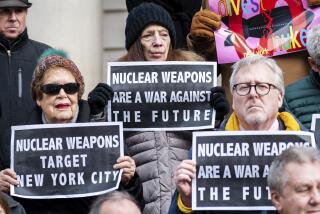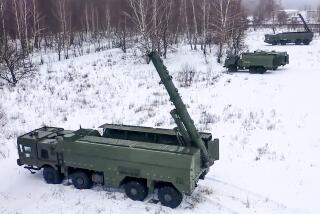Dressed--and Equipped--to Kill
- Share via
WASHINGTON — In times of war, military planners dream large.
They envision super soldiers, arriving silently by stealth helicopter, wearing temperature-controlled suits that can repel chemical and biological agents and make an individual nearly invisible by suppressing infrared and other telltale signatures, including body odor.
They envision silent guns and lightweight, blast-intensive explosives, futuristic arsenals of dazzling lasers and high-power microwave and acoustic weapons. They envision flying and crawling robots no larger than packs of cigarettes that can send back images and data from cave and bunker entrances.
This preview of 21st century warfare is described in a set of 2002 research and development documents under the overall title “U.S. SOCOM Technology Thrust Areas,” published by Special Operations Command, or SOCOM. The documents, circulated to defense contractors with clearance to develop military technology, aim to spur research into areas of particular interest to special operations forces. But they also serve as a vision of the future.
The Special Operations Command, riding high on its successes in Afghanistan, is in a good position to state its vision. As the group’s commander, Air Force Gen. Charles R. Holland, told the Senate Armed Services Committee in March, the group’s “highest-priority principal missions” have become combating terrorism and countering weapons of mass destruction--goals that Congress has shown itself willing to fund.
SOCOM has seized the moment. As a letter to contractors accompanying its technology objectives report notes: “A dramatically shifting national security environment throughout the world underscores the need for continuing investment in science and technology. In spite of budget pressures to the contrary, special operations forces continue to depend on investment in new technologies to provide [its] warriors with the advantage their missions demand.”
But caution is in order. Part of the reason the highly motivated and capable special operations forces are so successful is that they can conduct their business in secret, with little scrutiny, which often puts them on the edge of the law. Envisioning the weapons of the future is just one part of the equation. Before rushing to fulfill the command’s vision, policymakers also need to consider the ultimate effect of those weapons.
In 1986, Congress consolidated all U.S. special operations forces under the newly created Special Operations Command. Today, the 47,000-strong force encompasses such celebrated units as the Army’s Green Berets and Rangers and the Navy SEALS as well as less-publicized Air Force special tactics units and the super-secret Delta Force, along with other units overseen by the Joint Special Operations Command.
Unlike with other military units, Congress provides separate research, development and acquisition funding directly to SOCOM, which allows the command--based in Tampa, Fla.--to develop equipment uniquely suited to its shadowy missions. Its procurement philosophy, Holland said, is simple: “We select the best and train for innovation: We are equipping the warrior, not manning the equipment.”
Since Sept. 11, SOCOM has capitalized on its enhanced prominence, using its ability to contract outside usual procurement rules to acquire new technologies that complement its mission. Just before Operation Enduring Freedom commenced in October, SOCOM reports it was able, in just seven days, to find, purchase and place in the hands of spotters in Afghanistan new binocular-like laser devices used to observe and precisely measure the three-dimensional coordinates of distant targets like caves. It is the kind of purchase that inspired Holland to tell the Senate committee that one of the lessons of Afghanistan is that “seemingly small investments in equipment could be devastating in the hands of a prepared operator.”
But SOCOM is also interested in the not-so-small investments in equipment. In the words of the documents, special forces “must adapt or be overcome by the new frontiers of technological change.” The documents predict that genetics, nano-technology and robotics “will sooner, rather than later,” replace nuclear, biological and chemical technologies. Special operations, it continues, “will have to adapt to these entities or become irrelevant.”
To that end, SOCOM calls on industry to develop innovations that will allow special forces to “leap ahead in technological change.” These technologies would include robotics, a whole new class of genetically engineered drugs for performance enhancement and protection against chemical and biological weapons, greatly enhanced explosives, “do-everything” sensors and sophisticated information and intelligence technologies. Crawling, flying and swimming robots are a particularly high priority because of their ability to get to “places that are impractical, impossible or too dangerous for the operator,” the documents say.
The ability of special forces to gain “access to denied areas and closed systems” is also key to the focus on “information operations”--that is, cyber and electronic warfare--in its future developments. Information operations, Holland told the Senate committee, have “the potential to help operators remain undetected and unlocated in hostile territory.” For SOCOM, this means using computer hacking techniques to conduct sabotage as well as manipulate the enemy’s information systems. If territory cannot be penetrated physically, the documents envision virtual operations to place the U.S. “in” enemy camps. Holland says his group intends “to actively pursue [such] capabilities and develop standing authority to employ [them] when needed.”
A second element of information operations discussed in the planning document is “influence operations,” including psychological warfare, counter-propaganda, deception and counter-deception. “The social sciences can provide a deeper understanding of the factors that influence human behavior and the dynamics of mass media interaction with society and the government. To achieve a desired effect, a psychological weapon may be a better choice than a physical one,” the document says.
But physical weapons also have their place. The document outlines a commitment to fielding the first generation of “directed energy weapons”--lasers, microwave, radio-frequency or electromagnetic-pulse devices where energy, rather than explosives or projectiles, would be used “to kill, neutralize or suppress enemy or civilian personnel as well as incapacitate vehicles, ships or aircraft.” Versatility too is stressed: “The weapons of the future must not only be lethal but also be able to be ‘tuned’ for nonlethal application of force.”
Employing all of this technology, of course, is the super-soldier himself. These soldiers, SOCOM stresses, need to operate covertly in austere and extreme environments and even in the presence of nuclear, biological or chemical weapons. The report urges industry to examine “all physiological, physical, mental, psychological and intellectual means to identify and counter the degradation of the [special forces troops] caused by the demands of sustained operations and extreme environments.” This is where the future vision is most ambitious, mentioning food, drugs, implants, vaccines and genetic engineering as areas of research. “The ultimate goal for [special forces] is to be able to operate in an environment [contaminated by nuclear, biological or chemical weapons] without any special equipment/clothing,” the document concludes.
What is missing from this vision of future combat is any acknowledgment that the weapons must also be in accordance with a 1995 American commitment not to develop blinding lasers and with other U.S. obligations under international law to ensure that our weapons do not indiscriminately affect civilians or cause “unnecessary suffering.”
As the U.S. continues its campaign against Al Qaeda and prepares for full-scale war with Iraq, special forces and CIA paramilitary capabilities will be an active covert counterpart to the highly visible conventional air, ground and naval forces. We know these forces are capable, but we also need to consider how they accomplish their goals.
In the end, a country must answer for its tactics--even if it wins militarily. Secret operations conducted outside the law can come with a high political cost. Composing a wish list for future weaponry certainly has its place, but the ultimate goal of military planning has to be victory both on the battlefield and in the political arena. We have to hope someone is doing equally meticulous planning on the political end. Otherwise, our omnipotent fighting force might just provoke terrorists to find new and exotic ways to harm Americans--both on and off the battlefield.
More to Read
Sign up for Essential California
The most important California stories and recommendations in your inbox every morning.
You may occasionally receive promotional content from the Los Angeles Times.










